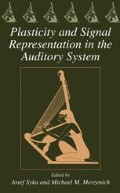4. Conclusion
Although switching a monaurally presented sound from one ear to the other evoked much larger negative difference potentials, we concluded that lateralization change in MMN studies must be made by altering the binaural cues, either by changing interaural time and/or level disparities under dichotic conditions, or by using loudspeakers. This was because our results indicated a significant role of different states of refractoriness for the responses to standard and deviant monaural stimuli, which is a clear violation of conditions for a genuine, memory comparison based MMN.
Access this chapter
Tax calculation will be finalised at checkout
Purchases are for personal use only
Preview
Unable to display preview. Download preview PDF.
References
Butler, R. A., Spreng, M., and Keidel, W. D., 1969, Stimulus repetition rate factors which influence the auditory potential in man. Psychophysiology 5: 665–672.
Gomes, H., Ritter, W., and Vaughan, H. G., Jr., 1995, The nature of preattentive storage in the auditory system. J. Cognitive Neurosci. 7: 81–94.
Jacobsen, T., and Schröger, E., 2001, Is there pre-attentive memory-based comparison of pitch? Psychophysiology 38: 723–727.
Jacobsen, T., Schröger, E., Horenkamp, T., and Winkler, I., 2003, Mismatch negativity to pitch change: varied stimulus proportions in controlling effects of neural refractoriness on human auditory event related brain potentials. Neurosci. Let. 344: 79–82.
Näätänen, R., 1995, Mismatch negativity: a powerful tool for cognitive neuroscience. Ear Hear. 16:6–18
Näätänen, R., and Alho, K., 1995, Mismatch negativity-a unique measure of sensory processing in audition. Intern. J. Neurosci. 80: 317–337.
Näätänen, R., Gaillard, A., and Mäntysalo, S., 1978, Early selective attention reinterpreted. Acta Psychol. 42: 313–329.
Näätänen, R., Jiang, D., Lavikainen, J., Reinikainen, K., and Paavilainen, P., 1993, Event-related potentials reveal a memory trace for temporal features. Neuroreport 5: 310–312.
Näätänen, R., and Picton, T. W., 1987, The N1 wave of the human electric and magnetic response to sound: a review and an analysis of component structure. Psychophysiology 24: 375–425.
Paavilainen, P., Karlsson, M.-L., Reinikainen, K. and Näätänen, R., 1989, Mismatch negativity to change in spatial location of an auditory stimulus. Electroenceph. Clin. Neurophysiol. 73: 129–141.
Schröger, E., and Wolff, C., 1996, Mismatch response of the brain to changes in sound location. Neuroreport 7: 3005–3008.
Schröger, E., 1997, On the detection of auditory deviations: A pre-attentive activation model. Psychophysiology 34: 245–257.
Sinkkonen, J., and Tervaniemi, M., 2000, Towards optimal recording and analysis of the mismatch negativity. Audiol. Neurootol. 5: 235–246.
Takegata, R., Paavilainen, P., Näätänen, R., and Winkler, I., 1999, Independent processing of changes in auditory single features and feature conjunctions in humans as indexed by the mismatch negativity. Neurosci. Let 266: 109–112
Winkler, I., Tervaniemi, M., Schröger, E., Wolff, C., and Näätänen, R., 1998, Preattentive processing of auditory spatial information in humans. Neurosci. Let. 242: 49–52.
Author information
Authors and Affiliations
Editor information
Editors and Affiliations
Rights and permissions
Copyright information
© 2005 Springer Science+Business Media, Inc.
About this paper
Cite this paper
Ungan, P., Yagcioglu, S. (2005). True Auditory Lateralization Mismatch Responses Can Be Obtained by Changing the Binaural Cues Rather Than by Switching a Monaurally Presented Sound from One Ear to the Other. In: Syka, J., Merzenich, M.M. (eds) Plasticity and Signal Representation in the Auditory System. Springer, Boston, MA . https://doi.org/10.1007/0-387-23181-1_30
Download citation
DOI: https://doi.org/10.1007/0-387-23181-1_30
Publisher Name: Springer, Boston, MA
Print ISBN: 978-0-387-23154-9
Online ISBN: 978-0-387-23181-5
eBook Packages: Biomedical and Life SciencesBiomedical and Life Sciences (R0)

